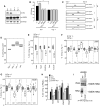ROS-triggered phosphorylation of complex II by Fgr kinase regulates cellular adaptation to fuel use
- PMID: 24856931
- PMCID: PMC4274740
- DOI: 10.1016/j.cmet.2014.04.015
ROS-triggered phosphorylation of complex II by Fgr kinase regulates cellular adaptation to fuel use
Abstract
Electron flux in the mitochondrial electron transport chain is determined by the superassembly of mitochondrial respiratory complexes. Different superassemblies are dedicated to receive electrons derived from NADH or FADH2, allowing cells to adapt to the particular NADH/FADH2 ratio generated from available fuel sources. When several fuels are available, cells adapt to the fuel best suited to their type or functional status (e.g., quiescent versus proliferative). We show that an appropriate proportion of superassemblies can be achieved by increasing CII activity through phosphorylation of the complex II catalytic subunit FpSDH. This phosphorylation is mediated by the tyrosine-kinase Fgr, which is activated by hydrogen peroxide. Ablation of Fgr or mutation of the FpSDH target tyrosine abolishes the capacity of mitochondria to adjust metabolism upon nutrient restriction, hypoxia/reoxygenation, and T cell activation, demonstrating the physiological relevance of this adaptive response.
Copyright © 2014 Elsevier Inc. All rights reserved.
Figures







References
-
- Acín-Pérez R, Bayona-Bafaluy MP, Bueno M, Machicado C, Fernández-Silva P, Pérez-Martos A, Montoya J, López-Pérez MJ, Sancho J, Enríquez JA. An intragenic suppressor in the cytochrome c oxidase I gene of mouse mitochondrial DNA. Hum Mol Genet. 2003;12:329–339. - PubMed
Publication types
MeSH terms
Substances
Grants and funding
LinkOut - more resources
Full Text Sources
Other Literature Sources
Molecular Biology Databases
Miscellaneous

